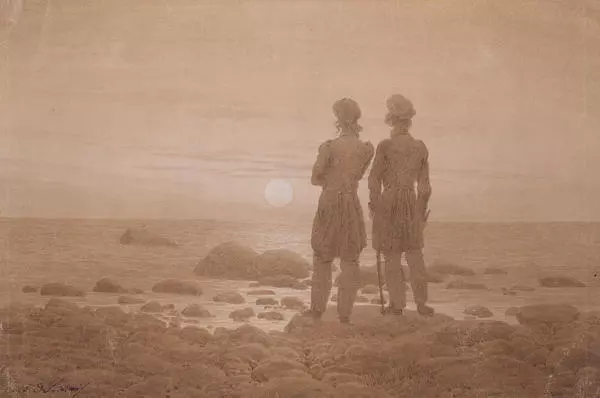The State Pushkin Museum houses a painting by the 19th-century German artist, Caspar David Friedrich. The artwork depicts friends standing together, with their backs turned to the viewer, in the moonlight, near the iron guard rail of Brühl’s Terrace on the banks of the Elbe River in Dresden. The figures depicted are the brothers, Alexander Ivanovich and Sergey Ivanovich Turgenev, as well as Vasily Andreyevich Zhukovsky.
In 1817, Zhukovsky began teaching Russian to the Grand Duchess Alexandra Feodorovna and accompanying her on trips throughout Russia and Europe. In 1821, a trip to Germany was planned. During his visit to Dresden in June of that year, Zhukovsky met the artist Caspar Friedrich, whose style and worldview resonated with his own. Subsequently, Zhukovsky acquired several paintings by Caspar for his office.
In the autumn of 1826, most likely during the first few weeks of their joint stay in Dresden, Zhukovsky commissioned Friedrich to paint a portrait of the Turgenevs and himself. The painting was mostly completed by the beginning of 1827. On May 20, 1827, Sergey Turgenev passed away in the arms of his brother Alexander and Vasily Zhukovsky. For Zhukovsky and the elder Turgenev, this portrait became a symbol of their unbreakable friendship and the time they spent in Dresden.
In a letter from December 1827, Alexander Turgenev wrote to his friend Vasily Zhukovsky, “It will soon be one year since the painting was created, which features all three of us: I beg you, my dear friend and brother, preserve it, as a reminder of our times together. I continue to look into the distance; I find solace in the knowledge that our lives will soon end as well. Friedrich’s star in the cloudy sky was a sign that our brother would be there soon. At the time, we did not fully understand the meaning of this omen. We had other things on our mind. There were still three of us on this earth. But he was already illuminating us, from that world, with a quiet and everlasting light.“
Subsequently, the painting was acquired by Yury Konstantinovich Yuryev (1896–1965), a professor of chemistry at Moscow State University, and then passed to his daughter, Yevgenia Yuryevna (1920–1991), who was the head of the French Department at the Institute of Foreign Languages. In 1991, in anticipation of the 200th anniversary of Alexander Sergeyevich Pushkin’s birth, this painting was donated to the museum by Vitaly Nikolayevich Rybalko (a philologist, head of the French Department at Moscow University, and World War II veteran), Yevgenia’s husband. According to Vitaly Rybalko, the father and daughter wished to bequeath the painting to the State Pushkin Museum.





